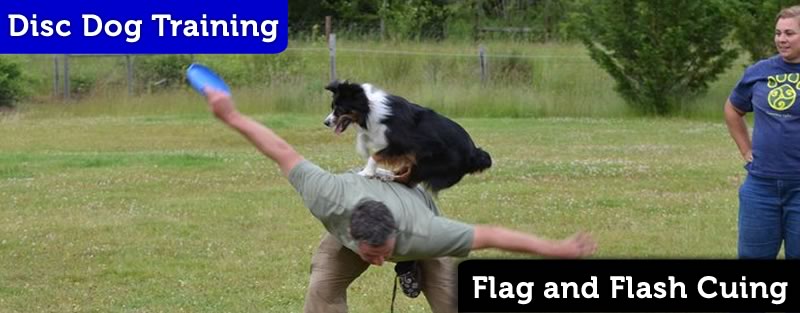
Flag and Flash Cuing
Loose Performance
Flag and Flash Cuing is a great tool for obtaining Overs and Vaults, and sharp movement to a position, but due to the nature of the skill – flying to the place where reinforcement happens – the performance of the skills are loose. It’s riding on the edge of control.
If you are looking for tight and clean performance of a behavior, this flag and flash cuing will need to be supplemented with foundational training.
Verbal and Target Cue
The Presentation of the target needs to happen in a manner that triggers prey drive. Sharp, fast, quick – the presentation needs to be exciting enough to get the dogs attention to pop onto the target.
The Verbal cue is paired with this sharp presentation of the target. Both the Verbal and the sharp, fast,quick presentation of the object will become cues to bite.
Bite as Cookie
If a dog has the concept of Bite as Cookie, success on this skill is highly likely. The self control that a dog exhibits when working Bites as Cookies is important to keep them stable while getting set up and the value of the bite as cookie helps a dog commit to flying at the target.
Wait with Bite
If Attention and PositionIn the Play+ philosophy, "Position" is the final stage within the "Next" phase of a Cycle of Play. It acts as a pivotal link between the "Next" phase and a new "Now" phase. More have a strong reward history, cue or lure the dog into position, mark the arrival into position or wait for offered eye contact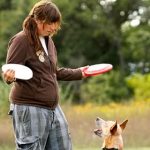 Unsolicited eye contact or Attention is a great way to hook up with a dog. If you have something the dog wants he should give eye contact in order to get access to... More to mark. After the mark wait a moment… The dog should wait trying to figure out where the bite will happen. It is not hard to stretch this out to a nice three to five second wait.
Unsolicited eye contact or Attention is a great way to hook up with a dog. If you have something the dog wants he should give eye contact in order to get access to... More to mark. After the mark wait a moment… The dog should wait trying to figure out where the bite will happen. It is not hard to stretch this out to a nice three to five second wait.
Set Up on the Fly
One way to get around having to worry about keeping a dog in position is to use a Bite as the cookie for a cued Drop.
Toss the toy or pull the dog into position using the tug and cue the drop. The drop is marked and reinforced with the presentation of the Target for the bite.
While this setting up on the fly works, it creates a loose game that can easily get out of control. Working at a slower pace with well executed waits and positional cues is something that should be learned and practiced.






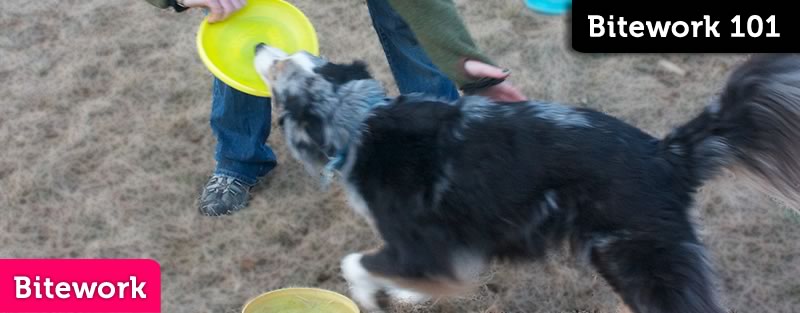
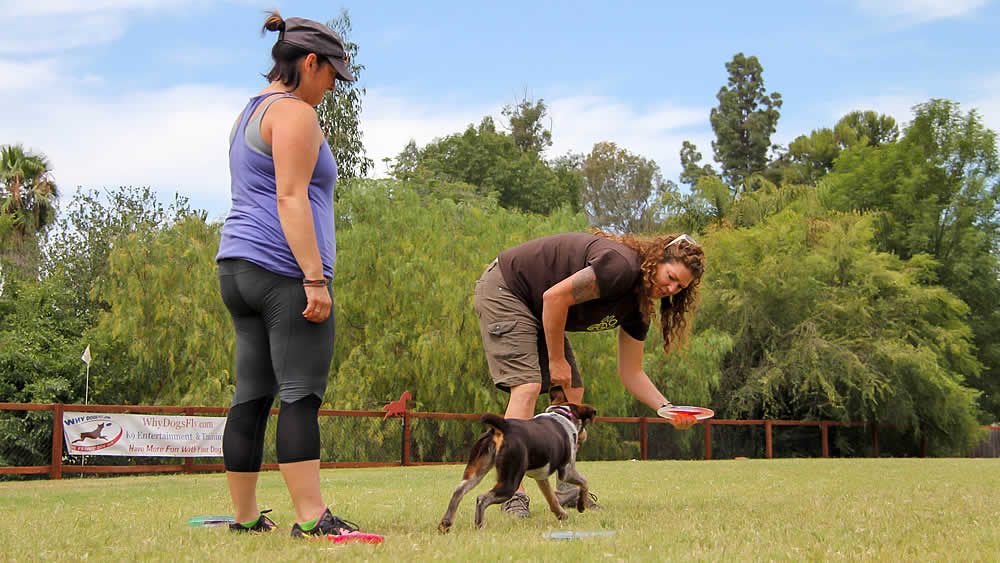
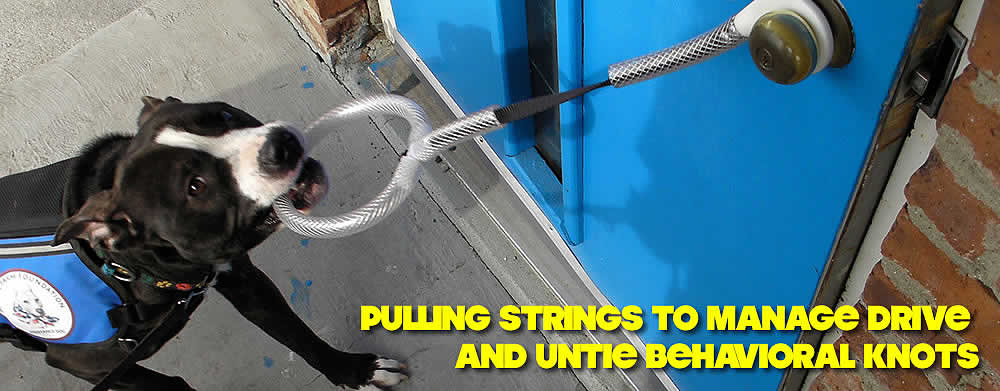
Okay, well, since I am STILL waiting for some video of the elusive Darwin (and whatever other dogs are lurking in this class), I figured I’d fill some time with a little more work with Sam. Here we’re inside for part– trying to reinforce his freakishly gentle bite, first with treats, then with some tosses– and then we go outside for a while– where, among other things we try some waiting, some over-the-leg bites, some tosses in one direction and then another, and even a little flag and flash (such as it is: I’d never taken any video of our overs before; I notice that MY form could use work!). Anyway, like I said in the call, Ron, you’ll see that Sam is a lot more active and eager out-of-doors (and in this clip he’s not even fully amped).
http://blip.tv/file/4787617
Your move, Sheridan!
-Jeff (and Sam)
The target needs to move swiftly. Like a Punch, think Kung Fu not Tai Chi.
Tossing Toys
Work from the center of the room and toss the toys in both directions.
The regrab is good.
@1:40 – Don’t break stuff, Jeff! lol
This should be the end of your session. You get him a iittle jazzed up and then tell him he’s a good boy and Go Do Dog Stuff.
Like the attempt to Jazz him up at around @2:15 – don’t go for the legs, tap him on the rib cage.
@2:35 the Bite for Toss is good.
@3:00 would have been a good time to quit. He really starts to turn on. Not saying you have to quit when he starts to turn on, but you should be quitting this game when he’s fired up and high, not when he’s low. Ideally, he’s only high when playing this game. You can see the letdown after that moment of being high @3:10 – lol @ the open door on the end table.
Outside with Sticks
Be VERY careful using sticks. I’d go as far as sanding them down and rounding them off – one bad pounce could be catastrophic. Saying this seriously and from some friends experiences.
This is a much better space.
If he checks out, do nothing. Just wait. Capture attention on you, Mark it and Reward with the Action of the Bite.
@4:06, good regrab, that would be another thing that I’d look to capture after he checks out.
@4:25 – good place to quit – he’s high…
Don’t chase him… Capture that Reorientation, a look towards you, a Drop, something, but don’t engage with him when he tarries out there with the toy. He’s asking you to come play with his game with him and you are obliging.
Shorter Sessions
Your sessions should be about 30 seconds long, not much more. I think Sam really likes the game, so if he doesn’t get to play because he’s screwing around and you quit, it will mean something.
Also, if you can get and keep him in a high state during play, he’ll come to expect that.
Right now, the game gets rolling and Sam gets nervous, checks out and displaces, because it’s not normal – it’s just not right.
Good job, man! Shorter sessions and quit earlier. Don’t be afraid to get set up and put the toys away if Sam doesn’t turn on right away. You can give him another shot a few minutes later.
Thank you thank you thank you, Ron. I will tell you one story about breaking stuff: about a week ago I was trying to encourage the bite with some tugging. I thought Sam had a firm grip on the toy and gave it a little jerk. Out of my hand it flew, knocking a picture off the mantelpiece and shattering the glass. How do you think that went over for a flinchy dog like Sam?
Shorter sessions; quitting when Sam’s high– grrrrr! My achilles heel!
Only one question about your comments. This one:
“Right now, the game gets rolling and Sam gets nervous, checks out and displaces, because it’s not normal – it’s just not right.”
Not sure I know what you mean there (and I always figure Sam’s “displacing” is just more of his general fearful hyper-vigilance).
Displacement happens do to stress. Not all stress is bad.
So what happens is he starts to get out of his comfort zone, the nice slow game you guys have cultivated, and he gets high. Not being experienced at getting high in that situation makes him uncomfortable. So he checks out.
Displacement behaviors are similar to the nervous ticks we see people have. A stutterer for instance. Gets excited and can’t quite spit it out. It doesn’t just happen when the person who stutters is bad stressed, any kind of stress can do it.
It’s just inexperience vs experience. He is inexperienced at being really high – losing his mind for the toy – and he is very experienced at being cool calm Sam.
You need to turn off the game when he’s starting to get high so he can have some experience wanting more. As it is now you are playing into cool, calm Sam and reinforcing the Checking out.
Make more sense?
Yes, makes more sense. I do reinforce the checking out; in fact, I am always chasing him and hectoring him to play. No more.
The first step is just to admit I have a problem. I’m on the road to recovery.
Oh and the Flag and Flash stuff is quite well executed on your part.
Mechanically things are sound. A little more Rewarding with Action.
Peace
Oh, two last things: thanks for the warning on the sticks. I will try not to play with them, but sometimes Sam finds them around the yard; I wanted to try and take advantage of a high value item.
Also, I filmed that inside part before you taught me the toss in one direction then the other thing, which we’ve been doing since. We had two totally kick-ass sessions doing that outside– with discs!– yesterday, maybe the best ever. He was really geeked, running for rollers one way, then the other, flying back to me and over my leg for a bite at full speed. So cool!
YEA! Go Sam! Good job, Jeff… Adding the stuff above to that mix could be the secret sauce.
Jeff
U-tube and my cam corder weren’t on speaking terms when it came to the audio, but I’ve found a way finally to fix that. I have posted one video on Darwin’s early tugging… and now I have video of Darwin and two of Bruno… However, they don’t fit with this topic, so I’ll see where they might be a better fit. I’m working on the homework video this week.
Bruno is not as energetic or focused indoors as he is outdoors…. but Bruno does the close stuff so he can be rewarded with long throws… and I don’t have a room big enough room or garage for long throws.
Ron… is that normal for the dogs to not be as energetic inside as outdoors? Also, a bit off topic, am I asking for trouble using long throws in a freestyle routine as a reward for the close work?
Sheridan
Sheridan,
Glad you got your tech issues resolved.
It is common for dogs to have a different level of play indoors vs outdoors, but that is kind of a catch-22 especially in Bruno’s case (just an educated guess…)
Your problem here is that the game that you have cultivated is a game of long throws, so short stuff is not within in realm the game, or if it is, it’s an extremely lame version of that long throw game.
peace
I was able to video the second half of Bruno’s reintroduction into back overs and back stalls. I’m staying as low as possible for these until he has his strength and confidence back. He was a bit tired by the time I turned the camera on but we did get a few in. Last two on the video were to be stalls, but his back legs were a bit tired and he was working too hard to keep balance so I elected to delay working on holding the stall longer. Watching the video, I think my stall queue is a bit unclear as well.
http://www.youtube.com/watch?v=deCavig1HSw
I have nothing from Darwin as he doesn’t want to tug anything at the moment. However, he is doing great in agility performing front and rear crosses, jumps, tunnels, etc. Loves to run and jump. Even likes the teeter. I think I am unable to make the tug game as fast paced and interesting as running around an agility course. I’m trying to figure my way through that as I am sure this is a handler issue.
Sheridan
Hey Sheridan!
Good stuff!
Just a couple of things…
Your flag is too low. I’m sure Bruno can barely see it. Lift that up there.
Reward for Position
Go back to Lindsay and Juicy’s Chaos to Consequent Game
Ask for the Drop as he’s going around the back of you. He’ll drop in the vaulting set up spot, most likely. Mark when is in the spot that will help him stop (you may or may not mark the Drop, personal preference…). Then reinforce with the Flag.
Less is More
Right now it’s all quite mushy. He’s running around, you are negotiating with him, moving your hand this way and that… all of this is reinforcing the confused “Which Way do I Go? Which Way Do I Go?” behavior… just wait. If he sets up in the wrong spot, then you can move him over there with a lure. It is really important for him to get very little reinforcement from you while he is trotting around you in that anxious state.
There should be 3 words. Yes! Wait… and the Bite Cue. and Wait is not even necessary.
The Flag
The Flag is low and lame. It’s not triggering prey drive. Once you start rewarding for position, he will bump up in intensity, and when you start to really pop that Flag up there so he can see it, sharply, so that it triggers his prey drive, Bruno will be much more aggressive.
If you notice, the height you are setting the target, Bruno can barely see it. Also when he’s going over, his head is looking down and nearly scraping your back it’s so low. That is because he’s putting his head where you are setting the target.
Also, if you notice your tapping of the back? Everyone thinks this works because it is telling the dog where the platform is. They think that the tapping onto the body is the cue. It’s not. The thing the dog sees and is interested by is the target moving up, off of the body in between the taps. Don’t believe me? Tap the target and hold it there and see what the dog does.
Then tap and lift the target and see what the dog does.
I love the length of your sessions, Sheridan.
Peace
HELP, I still can’t find section III but you have to remember that my OLD age might have something to do with it! I’m sure if I let Blurr have my lap top, we’d have it in a minute!